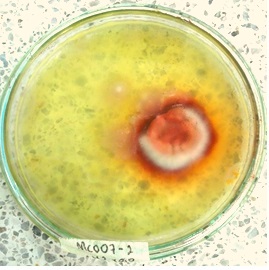Cytotoxic effect of Deoxynivalenol on the proliferation of the HepG2 cell line
Efecto citotóxico de Deoxinivalenol sobre la proliferación de la línea celular HepG2

Show authors biography
Objetive. To determine the cytotoxic effect and induction of apoptosis of Deoxynivalenol (DON) on the human hepatocarcinoma cell line (HepG2). Materials and methods. The HepG2 cell line was exposed to concentrations of 10, 25, 50 and 75 µM of lyophilized DON for 48 and 72 hours. Subsequently, the cytotoxic activity of DON was evaluated using the MTT assay. Finally, it analyzed the morphological changes of apoptosis in HepG2 cells by transmission electron microscopy, after treatment with 50 μM of DON for 48 hours. Results. DON, affects the metabolic activity and proliferation of HepG2 cells above 10 µM, compared to the control. The IC50 of DON on HepG2 cells, 42.8 µM SD±1.12 and 29.6 µM SD±3.1 at 48 hours and 72 hours of treatment, respectively. The morphological characteristics of apoptosis in HepG2 cells, such as nuclear and cellular fragmentation, invagination of the plasma membrane, and the formation of apoptotic bodies. Conclusions. DON is a cytotoxic agent in HepG2 cells that alters cellular metabolic activity, with a significant antiproliferative effect dependent on concentration and exposure time, and induces apoptotic cell death.
Article visits 732 | PDF visits
Downloads
- Mayer E, Novak B, Springler A, Schwartz-Zimmermann H, Nagl V, Reisinger N, et al. Effects of deoxynivalenol (DON) and its microbial biotransformation product deepoxy-deoxynivalenol (DOM-1) on a trout, pig, mouse, and human cell line. Mycotoxin Res. 2017; 33(4):297–308. https://link.springer.com/article/10.1007/s12550-017-0289-7
- Pestka J. Toxicological mechanisms and potential health effects of deoxynivalenol and nivalenol. World Mycotoxin J. 2010; 3(4):323–347. https://doi.org/10.3920/WMJ2010.1247
- Pinton P, Tsybulskyy D, Lucioli J, Laffitte J, Callu P, Lyazhri F, et al. Toxicity of deoxynivalenol and its acetylated derivatives on the intestine: Differential effects on morphology, barrier function, tight junctions proteins and MAPKinases. Toxicol Sci. 2012; 130(1):180–190. https://www.ncbi.nlm.nih.gov/pubmed/22859312
- Ren Z, Wang Y, Deng H, Deng Y, Deng J, Zuo Z, et al. Deoxynivalenol induces apoptosis in chicken splenic lymphocytes via the reactive oxygen species-mediated mitochondrial pathway. Environ Toxicol Pharmacol. 2015; 39(1):339–346. https://www.ncbi.nlm.nih.gov/pubmed/25553575
- Arunachalam C, Doohan F. Trichothecene toxicity in eukaryotes: Cellular and molecular mechanisms in plants and animals. Toxicol Lett. 2013; 217(2):149– 158. https://www.ncbi.nlm.nih.gov/pubmed/23274714
- Wu F, Groopman F, Pestka J. Public Health Impacts of Foodborne Mycotoxins. Annu Rev Food Sci Technol. 2014; 5:351–372. https://www.ncbi.nlm.nih.gov/pubmed/24422587
- Liao Y, Peng Z, Chen L, Nüssler A, Liu L, Yang W. Deoxynivalenol, gut microbiota and immunotoxicity: A potential approach? Food Chem Toxicol. 2018; 112:342–354. https://www.ncbi.nlm.nih.gov/pubmed/29331731
- Pistritto G, Trisciuoglio D, Ceci C, Garufi A, D’Orazi G. Apoptosis as anticancer mechanism: function and dysfunction of its modulators and targeted therapeutic strategies. Aging. 2016; 8(4):603–619. https://dx.doi.org/10.18632%2Faging.100934
- Gordeziani M, Adamia G, Khatisashvili G, Gigolashvili G. Programmed cell self-liquidation (apoptosis). Annals of Agrarian Science. 2017;15(1):148–154. https://www.sciencedirect.com/science/article/pii/S151218871630029X
- Redza M, Averill D. Activation of apoptosis signalling pathways by reactive oxygen species. Biochimica et Biophysica Acta (BBA) - Molecular Cell Research. 2016; 1863(12):2977–2992. https://doi.org/10.1016/j.bbamcr.2016.09.012
- Pestka J. Toxicological mechanisms and potential health effects of deoxynivalenol and nivalenol. World Mycotoxin J. 2010; 3(4):323–347. https://doi.org/10.3920/WMJ2010.1247
- Oshikata A, Takezawa, T. Development of an oxygenation culture method for activating the liver-specific functions of HepG2 cells utilizing a collagen vitrigel membrane chamber. Cytotechnology. 2015; 68(5):1801–1811. https://doi.org/10.1007/s10616-015-9934-1
- Pinton P, Oswald I. Effect of Deoxynivalenol and Other Type B Trichothecenes on the Intestine: A Review. Toxins. 2014; 6(5):1615-1643. https://www.ncbi.nlm.nih.gov/pmc/articles/PMC4052256/
- Juan A, Berrada H, Font G, Ruiz M. Evaluation of acute toxicity and genotoxicity of DON, 3-ADON and 15-ADON in HepG2 cells. Toxicology Letters. 2017; 280S: S254-S266.
- Kupcsik L. Estimation of Cell Number Based on Metabolic Activity: The MTT Reduction Assay. Mammalian Cell Viability. Methods Mol Biol. 2011; 740:13–19. https://doi.org/10.1007/978-1-61779-108-6_3
- Jaimes N, Salmen S, Colmenares M, Burgos A, Tamayo L, Mendoza V, et al. Efecto citotóxico de los compuestos de inclusión de paladio (II) en la beta-ciclodextrina. Biomédica. 2016; 36(4):603-611. https://doi.org/10.7705/biomedica.v36i4.2880
- Dinu D, Bodea G, Ceapa C, Munteanu M, Roming F, Serban A, et al. Adapted response of the antioxidant defense system to oxidative stress induced by deoxynivalenol in Hek-293 cells. Toxicon. 2011; 57(7-8):1023–1032. https://doi.org/10.1016/j.toxicon.2011.04.006
- Alassane I, Kolf M, Gauthier T, Abrami R, Abiola F, Oswald I. New insights into mycotoxin mixtures: the toxicity of low doses of Type B trichothecenes on intestinal epithelial cells is synergistic. Toxicol Appl Pharmacol. 2013; 272(1):191–198. https://doi.org/10.1016/j.taap.2013.05.023
- Fernández C, Elmo L, Waldner T, Ruiz M. Cytotoxic effects induced by patulin, deoxynivalenol and toxin T2 individually and in combination in hepatic cells (HepG2). Food Chem Toxicol. 2018; 120:12–23. https://doi.org/10.1016/j.fct.2018.06.019
- Lei Y, Guanghui Z, Xi W, Yingting W, Xialu L, Fangfang Y, et al. Cellular responses to T-2 toxin and/or deoxynivalenol that induce cartilage damage are not specific to chondrocytes. Sci Rep. 2017; 7(2231):1-14. https://www.nature.com/articles/s41598-017-02568-5
- Mikami O, Yamaguchi H, Murata H, Nakajima Y, Miyazaki S. Induction of apoptotic lesions in liver and lymphoid tissues and modulation of cytokine mRNA expression by acute exposure to deoxynivalenol in piglets. J Vet Sci. 2010; 11(2):107-113. https://dx.doi.org/10.4142%2Fjvs.2010.11.2.107
- Ma Y, Zhang A, Shi Z, He C, Ding J, Wang X, et al. A mitochondria-mediated apoptotic pathway induced by deoxynivalenol in human colon cancer cells. Toxicol in Vitro. 2012; 26(3):414–420. https://doi.org/10.1016/j.tiv.2012.01.010























